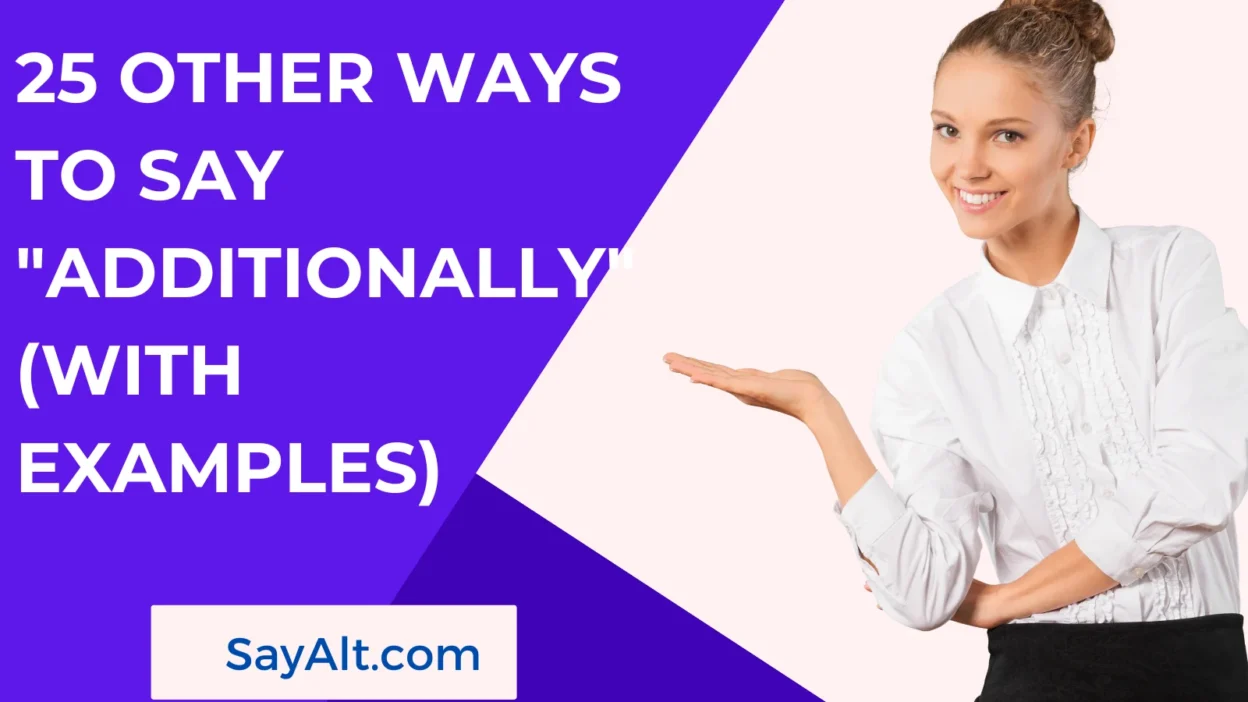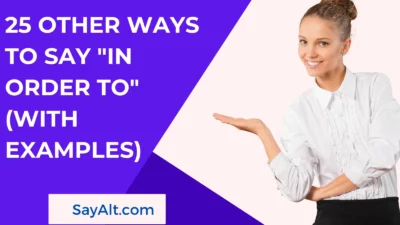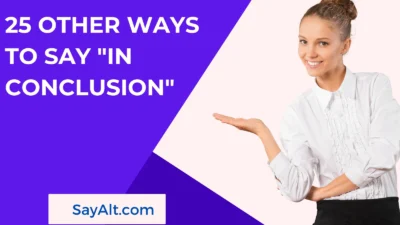The word “additionally” is a useful transition that helps link ideas, especially when you’re expanding on a point. It adds structure and flow to writing — particularly in formal or academic settings. But using “additionally” over and over can make your content sound mechanical or repetitive.
That’s why it’s helpful to have a diverse set of alternative phrases at your disposal. In this article, you’ll find 25 expressive and appropriate alternatives to “additionally,” each with a clear explanation, example, and guidance on tone and best use.
1. Moreover
Meaning:
Adds extra information that strengthens or reinforces a previous statement.
Detailed Explanation:
“Moreover” is a formal, academic-style word that suggests the added point is important and further supports your argument.
Scenario Example:
The project was completed ahead of schedule. Moreover, it came under budget.
Best Use:
Essays, formal writing, persuasive documents.
Tone:
Formal, strong, academic.
2. Furthermore
Meaning:
Continues a line of reasoning with another supporting point.
Detailed Explanation:
Very close to “moreover,” this is great when you want to emphasize continuity in thought.
Scenario Example:
The team exceeded its goals. Furthermore, client satisfaction increased significantly.
Best Use:
Research papers, business reports.
Tone:
Professional, polished, academic.
3. In Addition
Meaning:
Adds more information to support a statement.
Detailed Explanation:
Clear and professional, it works well when outlining multiple points or expanding an idea.
Scenario Example:
In addition to strong sales, the company saw record-breaking customer retention.
Best Use:
Formal writing, resumes, emails.
Tone:
Professional, structured, smooth.
4. Also
Meaning:
Adds another idea or point in a simple way.
Detailed Explanation:
This is a flexible, everyday word that can be used almost anywhere.
Scenario Example:
He’s skilled in graphic design. He also knows video editing.
Best Use:
Conversations, casual writing, general use.
Tone:
Neutral, easygoing, simple.
5. As Well
Meaning:
Means “too” or “in addition.”
Detailed Explanation:
Usually placed at the end of a sentence and sounds natural in speech.
Scenario Example:
She’s attending the workshop, and her colleague is joining as well.
Best Use:
Casual conversation, informal writing.
Tone:
Friendly, conversational.
6. What’s More
Meaning:
Adds surprising or important extra information.
Detailed Explanation:
Often used for emphasis or dramatic buildup.
Scenario Example:
He completed the project early. What’s more, he did it alone.
Best Use:
Storytelling, blog posts, persuasive writing.
Tone:
Emphatic, engaging, informal.
7. To Boot
Meaning:
Means “in addition” in a slightly old-fashioned or playful way.
Detailed Explanation:
Used after a list of positives to add something extra, often with flair.
Scenario Example:
She’s brilliant, kind, and funny to boot.
Best Use:
Creative writing, informal speech.
Tone:
Charming, informal, slightly old-school.
8. Not to Mention
Meaning:
Highlights something additional that’s important or impressive.
Detailed Explanation:
Used to introduce a final or extra point, often for emphasis.
Scenario Example:
The view was breathtaking, not to mention the luxurious amenities.
Best Use:
Persuasive writing, speeches, articles.
Tone:
Emphatic, engaging, persuasive.
9. On Top of That
Meaning:
Adds more information, usually in a casual tone.
Detailed Explanation:
Often used to stack multiple benefits or problems.
Scenario Example:
She’s managing the project flawlessly. On top of that, she’s mentoring a new hire.
Best Use:
Casual writing, conversations, blogs.
Tone:
Relaxed, conversational.
10. Along With That
Meaning:
Adds more content to the existing idea.
Detailed Explanation:
Suggests that something is occurring in tandem with another point.
Scenario Example:
Along with that announcement, the company also revealed new hiring plans.
Best Use:
Presentations, newsletters, reports.
Tone:
Professional, informative.
11. Likewise
Meaning:
Adds a point that is similar or aligned with a previous one.
Detailed Explanation:
Used to extend agreement or symmetry in writing.
Scenario Example:
The marketing team improved their process. Likewise, the design team saw better results.
Best Use:
Reports, academic papers, analytical writing.
Tone:
Balanced, formal, clear.
12. As Well As That
Meaning:
Adds a point to something already mentioned.
Detailed Explanation:
Often used for smooth transitions in spoken English.
Scenario Example:
He’s great at managing people, as well as that, he’s good with numbers.
Best Use:
Spoken English, informal writing.
Tone:
Natural, soft, flowing.
13. Too
Meaning:
Indicates something extra or in addition.
Detailed Explanation:
Short and conversational; usually comes at the end of a sentence.
Scenario Example:
She’s coming to the party too.
Best Use:
Casual speech, friendly writing.
Tone:
Easygoing, informal.
14. In Like Manner
Meaning:
Adds a similar point, often used in academic contexts.
Detailed Explanation:
More formal and less common in daily use but precise.
Scenario Example:
The first trial was successful. In like manner, the second showed similar results.
Best Use:
Academic or legal writing.
Tone:
Formal, academic.
15. To Say Nothing Of
Meaning:
Adds something significant that hasn’t even been discussed yet.
Detailed Explanation:
This phrase heightens the impact of the extra point.
Scenario Example:
He’s an excellent leader, to say nothing of his financial acumen.
Best Use:
Rhetorical writing, opinion pieces.
Tone:
Emphatic, dramatic, persuasive.
16. In the Same Way
Meaning:
Adds a point that mirrors or supports the last one.
Detailed Explanation:
Useful when comparing similar outcomes or behaviors.
Scenario Example:
She handled the challenge calmly. In the same way, he remained composed under pressure.
Best Use:
Comparative writing, essays.
Tone:
Neutral, structured.
17. Even More
Meaning:
Adds to an already impressive or surprising list.
Detailed Explanation:
Works well when stacking multiple benefits or features.
Scenario Example:
This phone is fast, has great battery life, and even more, it’s waterproof.
Best Use:
Sales copy, persuasive writing.
Tone:
Exciting, promotional.
18. In a Similar Fashion
Meaning:
Indicates that something is done or said in a way like the previous point.
Detailed Explanation:
Often used to maintain parallelism or symmetry in structured writing.
Scenario Example:
The northern team improved their workflow. In a similar fashion, the southern branch did too.
Best Use:
Formal writing, reports.
Tone:
Polished, academic.
19. To Continue
Meaning:
Introduces the next point in an ongoing explanation.
Detailed Explanation:
Keeps the flow of thought smooth and connected.
Scenario Example:
To continue, the results suggest a trend toward hybrid work.
Best Use:
Presentations, lectures.
Tone:
Professional, sequential.
20. Over and Above That
Meaning:
Adds something more, often unexpected or impressive.
Detailed Explanation:
Used to highlight a bonus point.
Scenario Example:
The course offers mentorship. Over and above that, it guarantees internships.
Best Use:
Promotional writing, pitches.
Tone:
Persuasive, promotional.
21. Too Much More
Meaning:
Adds emphasis to abundance or extras.
Detailed Explanation:
Suggests there’s plenty beyond what’s already mentioned.
Scenario Example:
This software offers templates, automation, and too much more.
Best Use:
Sales content, marketing copy.
Tone:
Exciting, informal.
22. Then Again
Meaning:
Introduces another point that contrasts slightly or adds nuance.
Detailed Explanation:
Can add balance or complexity to your ideas.
Scenario Example:
The weather looks fine. Then again, it may rain later.
Best Use:
Opinion writing, casual articles.
Tone:
Reflective, casual.
23. Additionally Speaking
Meaning:
Adds more information verbally or narratively.
Detailed Explanation:
Less common, but works in storytelling or conversational tones.
Scenario Example:
Additionally speaking, the plan includes free upgrades.
Best Use:
Presentations, informal speech.
Tone:
Light, semi-formal.
24. Besides That
Meaning:
Adds another idea while moving the conversation forward.
Detailed Explanation:
Helps avoid overusing “also” or “in addition.”
Scenario Example:
The room is small. Besides that, the location isn’t great either.
Best Use:
Conversations, informal writing.
Tone:
Natural, honest.
25. And What’s Even Better
Meaning:
Introduces a benefit or feature that exceeds expectations.
Detailed Explanation:
Perfect for persuasive writing where the tone is upbeat and enthusiastic.
Scenario Example:
You get lifetime access. And what’s even better — free updates for a year!
Best Use:
Marketing, sales, excitement building.
Tone:
Enthusiastic, positive, promotional.
Conclusion
The word “additionally” is clear and functional, but relying on it too much can flatten your writing. These 25 alternatives give you the tools to sound more persuasive, polished, or personable — depending on your audience.



